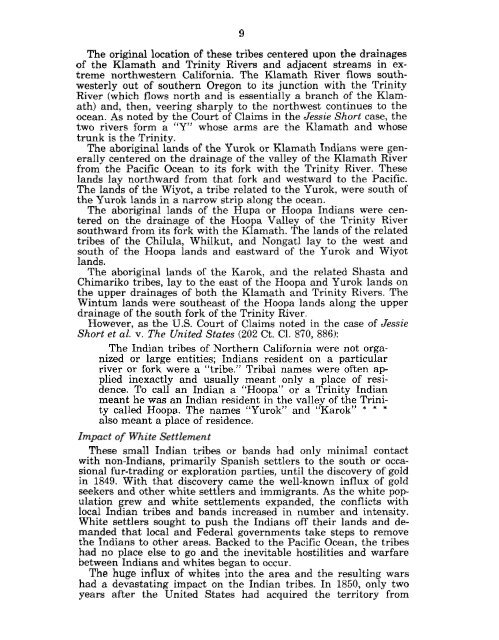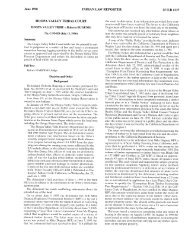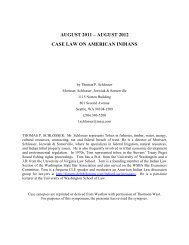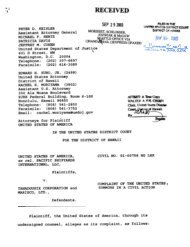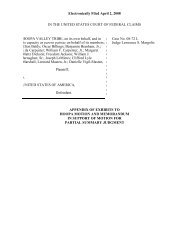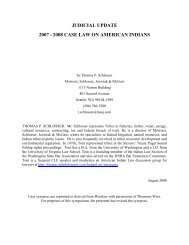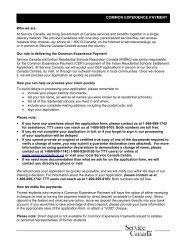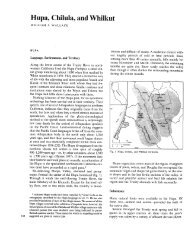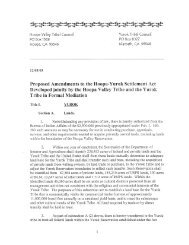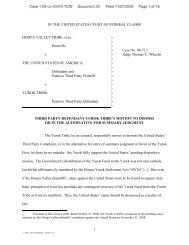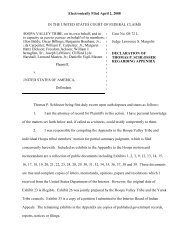8of the Task Force then serving. Thereafter, the term of such representative shall beas provided in section 4(e) of such Act.SEC. 12. TRIBAL TIMBER SALES PROCEEDS USE.Section 7 of the Act of June 25, 1910, as amended by the Act of April 30, 1964, (36Stat. 857; 25 U.S.C. 407) is amended to read as follows:“SEC. 7. Under regulations prescribed by the Secretary of the Interior, the timberon unallotted trust land in Indian reservations or on other land held in trust fortribes may be sold in accordance with the principles of sustained-yield managementor to convert the land to a more desirable use. After deduction, if any, for administrativeexpenses under the Act of February 14, 1920 (41 Stat. 415; 25 U.S.C. 4131, theproceeds of the sale shall be used-“(1) as determined by the government bodies of the tribes concerned and approvedby the Secretary, or“(2) in the absence of such a governing body, as determined by the Secretaryfor the tribe concerned.”.SEC. 13. LIMITATIONS OF ACTIONS: WAIVER OF CLAIMS.(a) Any claim challenging the partition of joint reservation pursuant to section 2or any other provision of this Act as having effected a taking under the FifthAmendment of the United States Constitution or as otherwise having provided inadequatecompensation shall be brought, pursuant to 28 U.S.C. 1491 or 28 U.S.C. 1505,in the United States Claims Court.(bKl) Any such claim by any person or entity, other than the Hoopa Valley Tribeor the Yurok Tribe, shall be forever barred if not brought within the later of 210days from the date of the partition of the joint reservation as provided in section 2or 120 days after the publication in the Federal Register - of the option election dateas required by section8i(a)(4).(2) Anv such claim bv the HooDa Vallev Tribe shall be barred 180 davs after thedate of ;?nactment of chis Act such garlier date as may be establiihed by theadoption of a resolution waiving such claims pursuant to section 2(a)(2).(3) Any such claim by the Yurok Tribe shall be barred 180 days after the generalcouncil meeting of the Yurok Tribe as provided in section 9 or such earlier date asmay be established by the adoption of a resolution waiving such claims as providedin section 9(c)(2)(Aj.(c)(l) The Secretary shall prepare and submit to the Congress a report describingthe final decision in any claim brought pursuant to subsection (b) against theUnited States or its officers, agencies, or instrumentalities.(2) Such report shall be submitted no later than 180 days after the entry of finaljudgment in such litigation. The report shall include any recommendations of theSecretary for action by Congress, including, but not limited to, any supplementalfunding proposals necessary to implement the terms of this Act and any modificationsto the resource and management authorities estblished by this Act.PURPOSEThe purpose of H.R. 4469, by Mr. Bosco, is to partition the landsof the Hoopa Valley Reservation in Humboldt County, California,between the Hoopa Valley Tribe and the Yurok Tribe in settlementof a dispute as to the ownership and management responsibilitiesfor such lands.HI s T o R YAboriginal Tribes and Lands of Northern CaliforniaThe lands of what is now northern California, like most of thePacific coastal area, were aboriginally inhabited by many smalltribes or bands of Indians of numerous linguistic stocks or derivations.Representative tribes in the general area of dispute includedthe Hoopa (Hupa), Chilula, Whilkut, and Nongatl of Athapascanderivation; the Yurok and Wiyot of Algonkian derivation; theKarok (Karuk), Shasta, and Chimariko of Hokan stock; and theWintun of the Penutian language.
9The original location of these tribes centered upon the drainagesof the Klamath and Trinity Rivers and adjacent streams in extremenorthwestern California. The Klamath River flows southwesterlyout of southern Oregon to its junction with the TrinityRiver (which flows north and is essentially a branch of the Klamath)and, then, veering sharply to the northwest continues to theocean. As noted by the Court of Claims in the Jessie Short case, thetwo rivers form a “Y” whose arms are the Klamath and whosetrunk is the Trinity.The aboriginal lands of the Yurok or Klamath Indians were generallycentered on the drainage of the valley of the Klamath Riverfrom the Pacific Ocean to its fork with the Trinity River. Theselands lay northward from that fork and westward to the Pacific.The lands of the Wiyot, a tribe related to the Yurok, were south ofthe Yurok lands in a narrow strip along the ocean.The aboriginal lands of the Hupa or Hoopa Indians were centeredon the drainage of the Hoopa Valley of the Trinity Riversouthward from its fork with the Klamath. The lands of the relatedtribes of the Chilula, Whilkut, and Nongatl lay to the west andsouth of the Hoopa lands and eastward of the Yurok and Wiyotlands.The aboriginal lands of the Karok, and the related Shasta andChimariko tribes, lay to the east of the Hoopa and Yurok lands onthe upper drainages of both the Klamath and Trinity Rivers. TheWintum lands were southeast of the Hoopa lands along the upperdrainage of the south fork of the Trinity River.However, as the US. Court of Claims noted in the case of JessieShort et al. v. The United States (202 Ct. C1. 870, 886):The Indian tribes of Northern California were not organizedor large entities; Indians resident on a particularriver or fork were a “tribe.” Tribal names were often appliedinexactly and usually meant only a place of residence.To call an Indian a “Hoopa” or a Trinity Indianmeant he was an Indian resident in the valley of the Trinitycalled Hoopa. The names “Yurok” and “Karok” * * *also meant a place of residence.Impact of White SettlementThese small Indian tribes or bands had only minimal contactwith non-Indians, primarily Spanish settlers to the south or occasionalfur-trading or exploration parties, until the discovery of goldin 1849. With that discovery came the well-known influx of goldseekers and other white settlers and immigrants. As the white populationgrew and white settlements expanded, the conflicts withlocal Indian tribes and bands increased in number and intensity.White settlers sought to push the Indians off their lands and demandedthat local and Federal governments take steps to removethe Indians to other areas. Backed to the Pacific Ocean, the tribeshad no place else to go and the inevitable hostilities and warfarebetween Indians and whites began to occur.The huge influx of whites into the area and the resulting warshad a devastating impact on the Indian tribes. In 1850, only twoyears after the United States had acquired the territory from


